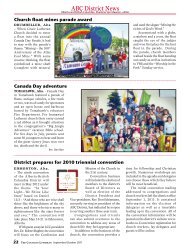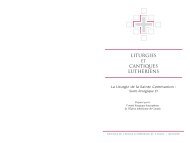Planned Giving Gift Summary - Lutheran Church-Canada
Planned Giving Gift Summary - Lutheran Church-Canada
Planned Giving Gift Summary - Lutheran Church-Canada
Create successful ePaper yourself
Turn your PDF publications into a flip-book with our unique Google optimized e-Paper software.
G. 32<br />
placement options have been very limited, and in some years (2010 for example) there were not enough placements<br />
for all the vicars which required the deferral of some vicarages to the student’s fourth year.<br />
A Shared Concern<br />
It is important to note that every congregation in the synod benefits from an effective vicarage program. Whether a<br />
congregation has had a vicar in their parish or not, they are still reaping the benefits through their pastor who was<br />
once a vicar. It can therefore be argued that a solid vicarage program is the responsibility of the entire synod. The<br />
task force thus believes that the synod should examine sharing the cost of training vicars instead of leaving the entire<br />
burden of the cost with the vicarage congregation. To see how this might be accomplished some essential statistics<br />
are listed below:<br />
2008 LCC Synodical Statistics<br />
52,654 confirmed members in LCC<br />
316 congregations in LCC<br />
229 (72%) were small with 1-199 confirmed members<br />
72 (23%) were medium with 200-499 confirmed members<br />
15 (5%) were large with 500-1000+ confirmed members<br />
Annual Vicarage Costs<br />
6-8 vicars are placed per year from the 2 seminaries<br />
Average cost for a vicar = $40,000<br />
Total cost per year for 8 vicars = $320,000<br />
Synod’s proposed portion of the total cost (50%) = $160,000<br />
Proposed Formulas for Cost Sharing Among LCC Congregations<br />
If synod chooses to subsidize vicarage congregations, then the funds would have to come from assessing the<br />
congregations of the synod. There are two possible ways to accomplish this; to assess each congregation per<br />
confirmed member, or to assess them according to their congregational size. The suggested amount for both options<br />
are outlined below.<br />
If cost is shared per confirmed member<br />
$160,000 ÷52,654 confirmed members= $3.04 per confirmed member<br />
If cost is shared per size of congregation<br />
Example # 1<br />
Annual support from<br />
Small congregations (100 confirmed members) $275 x 229 congregations = $62,975<br />
Medium (350 confirmed members) $1000 x 72 congregations = $72,000<br />
Large (750 confirmed members) $2250 x 15 congregations = $33,750<br />
TOTAL $168,725<br />
*{$8,725 overage}<br />
*Overage assumes that some congregations will not submit annual contributions.<br />
Example # 2<br />
Annual support from<br />
Small congregations (100 confirmed members) $500 x 229 congregations = $114,500<br />
Medium (350 confirmed members) $750 x 72 congregations = $ 54,000<br />
Large (750 confirmed members) $1000 x 15 congregations = $ 15,000<br />
TOTAL $183,500<br />
*{$23,500 overage}<br />
Vicarage Placement Assistance Fund<br />
Should an assessment be made of synodical congregations, then a system for collecting and distributing the funds<br />
would have to be established. Mr. Dwayne Cleave, Treasurer of LCC, suggested the following parameters for a<br />
potential Vicarage Placement Assistance Fund:<br />
1) All congregations would be billed an annual assessment based on communicant membership to support the<br />
vicarage program. The Districts would collect the funds from congregations and forward them to LCC.<br />
2) The LCC Vicarage Placement Fund would have maximum capital limit established by the Council of Presidents<br />
(Suggestion $240,000). This amount would cover approximately 50% of the cost of having 12 vicars placed.








